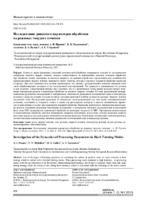Исследование динамики параметров обработки на режимах твердого точения

Date
2023Publisher
Another Title
Investigation of the Dynamics of Processing Parameters in Hard Turning Modes
Bibliographic entry
Исследование динамики параметров обработки на режимах твердого точения = Investigation of the Dynamics of Processing Parameters in Hard Turning Modes / А. И. Пронин [и др.] // Наука и техника. – 2023. – № 6. – С. 470-476.
Abstract
Одним из видов финишных операций механической обработки поверхности изделий из металлических материалов является твердое точение, которое осуществляется на повышенных режимах токарной обработки. При обработке сталей, закаленных на высокую твердость, на режимах обработки с проявлением всех особенностей, характеризующих твердое точение, выделяется много теплоты, которая в процессе токарной обработки переходит в стружку. При этом значения силы резания уменьшаются, что связано с разупрочнением активных поверхностных слоев обрабатываемого материала и его последующей пластификацией. Это приводит к уменьшению сил резания в зоне контакта. Существенный интерес как с научной, так и с практической точек зрения вызывает вопрос изменения температуры резания и параметров обработки на режимах твердого точения. В статье представлены экспериментальные результаты исследований и эмпирические зависимости радиальной составляющей силы и температуры резания от скорости резания и подачи на оборот при фиксированной глубине резания на режимах твердого точения закаленной стали. Исследования проводили на специально сконструированной для этих целей экспериментальной установке, состоящей из токарного станка и стенда для регистрации, контроля и анализа динамических процессов (в виде сигнала от резца) при проведении токарной обработки. В качестве испытуемого инструмента использова- ли резец со сменными режущими пластинами из керамики, а материалом заготовок для проведения исследований была сталь ХВГ, подвергнутая термической обработке на категорию твердости 55 HRC. Произведена компьютерная и математическая обработка методом наименьших квадратов полученных результатов, которая позволила вывести расчетные формулы для определения значений исследуемых факторов. Определены оптимальные значения факторов, соответствующие минимальному значению радиальной составляющей силы и температуре резания.
Abstract in another language
One of the types of finishing operations of machining the surface of products made of metal materials is hard turning, which is carried out at elevated turning modes. When processing steels hardened to high hardness, in processing modes with the ma-nifestation of all the features characterizing hard turning, a lot of heat is released, which turns into chips during turning, while the values of the cutting force decrease, which is associated with the softening of the active surface layers of the processed material and its subsequent plasticization, which leads to a decrease in cutting forces in the contact zone. A significant interest both from a scientific and practical point of view is the issue of changing the cutting temperature and processing parameters in hard turning modes. The paper presents experimental research results and empirical dependences of the radial component of the cutting force and temperature on cutting speed and feed per revolution, at a fixed cutting depth in the modes of hard turning of hardened steel. The research has been carried out on an experimental installation specially designed for this purpose, consisting of a lathe and a stand for recording, monitoring and analyzing dynamic processes (in the form of a signal from the cutter) during turning. A cutter with replaceable ceramic cutting plates was used as a test tool, and the material of the workpieces for the research was HVG steel, subjected to heat treatment for a hardness category of 55 HRC. Computer and mathematical processing of the results obtained using the least squares method was carried out, which allowed us to derive calculation formulas for determining the values of the studied factors. The optimal values of the factors corresponding to the minimum value of the radial component of the force and the cutting temperature are determined.
View/
Collections
- № 6[10]
